Strategic Human Resource Management Report for Indus Tours and Travel
VerifiedAdded on 2022/12/28
|15
|4613
|56
Report
AI Summary
This report provides a comprehensive analysis of the strategic human resource management (SHRM) within the Indus Tours and Travel industry. It begins with an introduction to the company and its operations, followed by an examination of current trends impacting HR strategies, particularly the role of technology, including artificial intelligence and recognition technology. The report then explores both internal and external influences on HR strategies, such as corporate goals, market changes, and social trends. It further evaluates key theories and concepts of SHRM, including universalistic, contingency, configurational, and contextual perspectives, and how these apply to the travel industry. The report also addresses change management models supporting HR strategy and concludes with a discussion of monitoring and measuring HR strategy outcomes, including sustainable performance and growth within the travel sector.
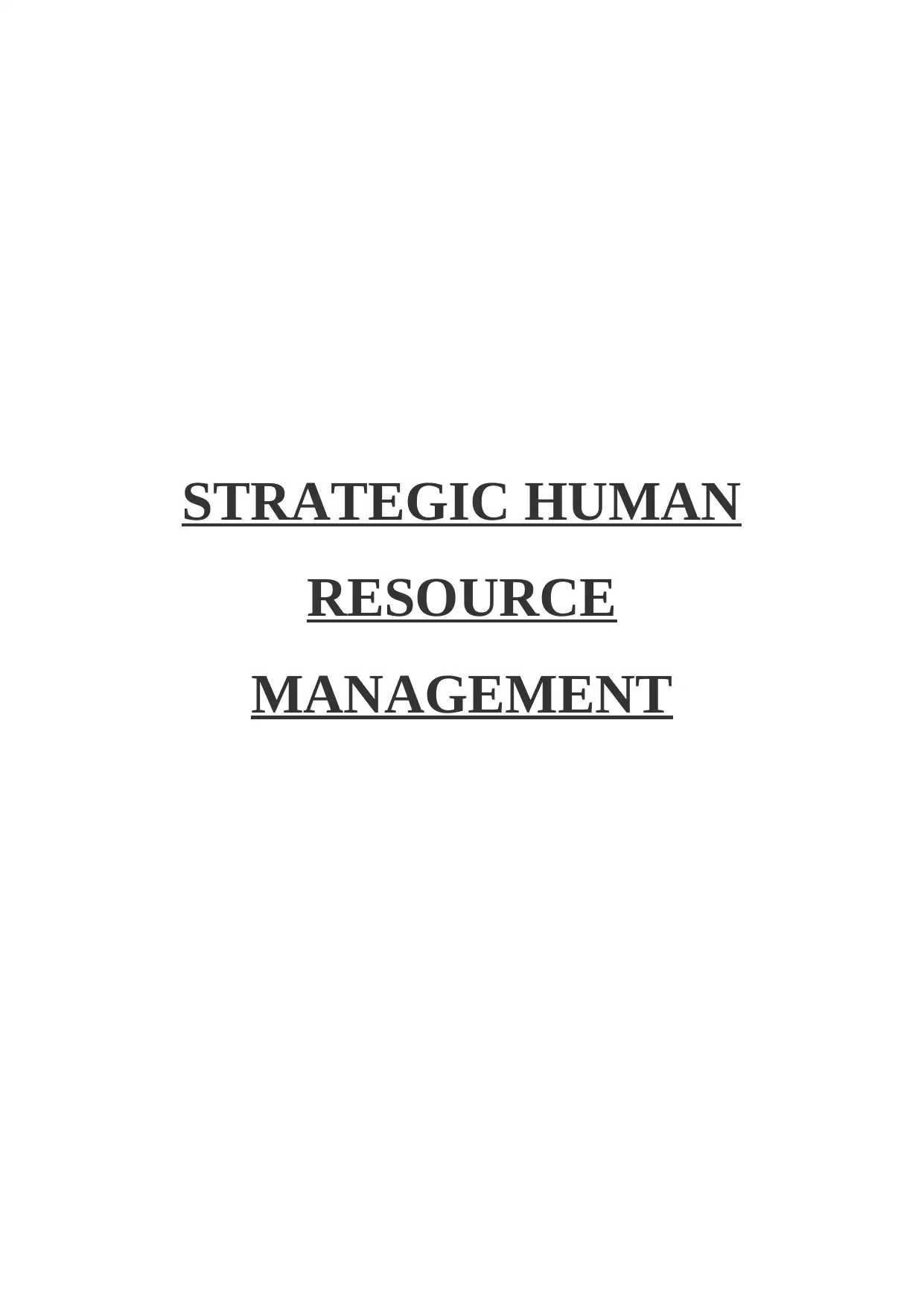
STRATEGIC HUMAN
RESOURCE
MANAGEMENT
RESOURCE
MANAGEMENT
Paraphrase This Document
Need a fresh take? Get an instant paraphrase of this document with our AI Paraphraser
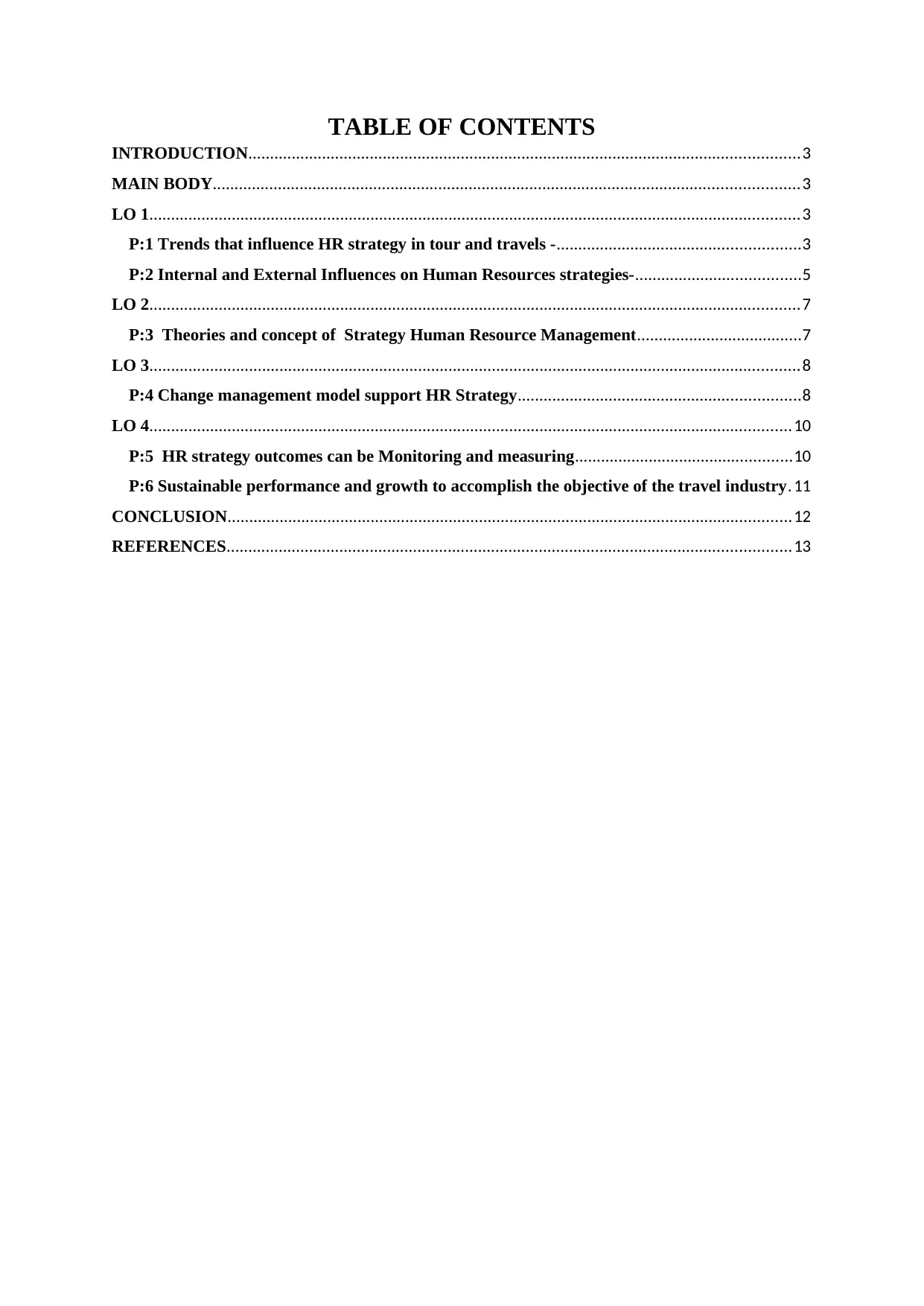
TABLE OF CONTENTS
INTRODUCTION...............................................................................................................................3
MAIN BODY.......................................................................................................................................3
LO 1......................................................................................................................................................3
P:1 Trends that influence HR strategy in tour and travels -........................................................3
P:2 Internal and External Influences on Human Resources strategies-......................................5
LO 2......................................................................................................................................................7
P:3 Theories and concept of Strategy Human Resource Management......................................7
LO 3......................................................................................................................................................8
P:4 Change management model support HR Strategy.................................................................8
LO 4....................................................................................................................................................10
P:5 HR strategy outcomes can be Monitoring and measuring..................................................10
P:6 Sustainable performance and growth to accomplish the objective of the travel industry. 11
CONCLUSION..................................................................................................................................12
REFERENCES..................................................................................................................................13
INTRODUCTION...............................................................................................................................3
MAIN BODY.......................................................................................................................................3
LO 1......................................................................................................................................................3
P:1 Trends that influence HR strategy in tour and travels -........................................................3
P:2 Internal and External Influences on Human Resources strategies-......................................5
LO 2......................................................................................................................................................7
P:3 Theories and concept of Strategy Human Resource Management......................................7
LO 3......................................................................................................................................................8
P:4 Change management model support HR Strategy.................................................................8
LO 4....................................................................................................................................................10
P:5 HR strategy outcomes can be Monitoring and measuring..................................................10
P:6 Sustainable performance and growth to accomplish the objective of the travel industry. 11
CONCLUSION..................................................................................................................................12
REFERENCES..................................................................................................................................13
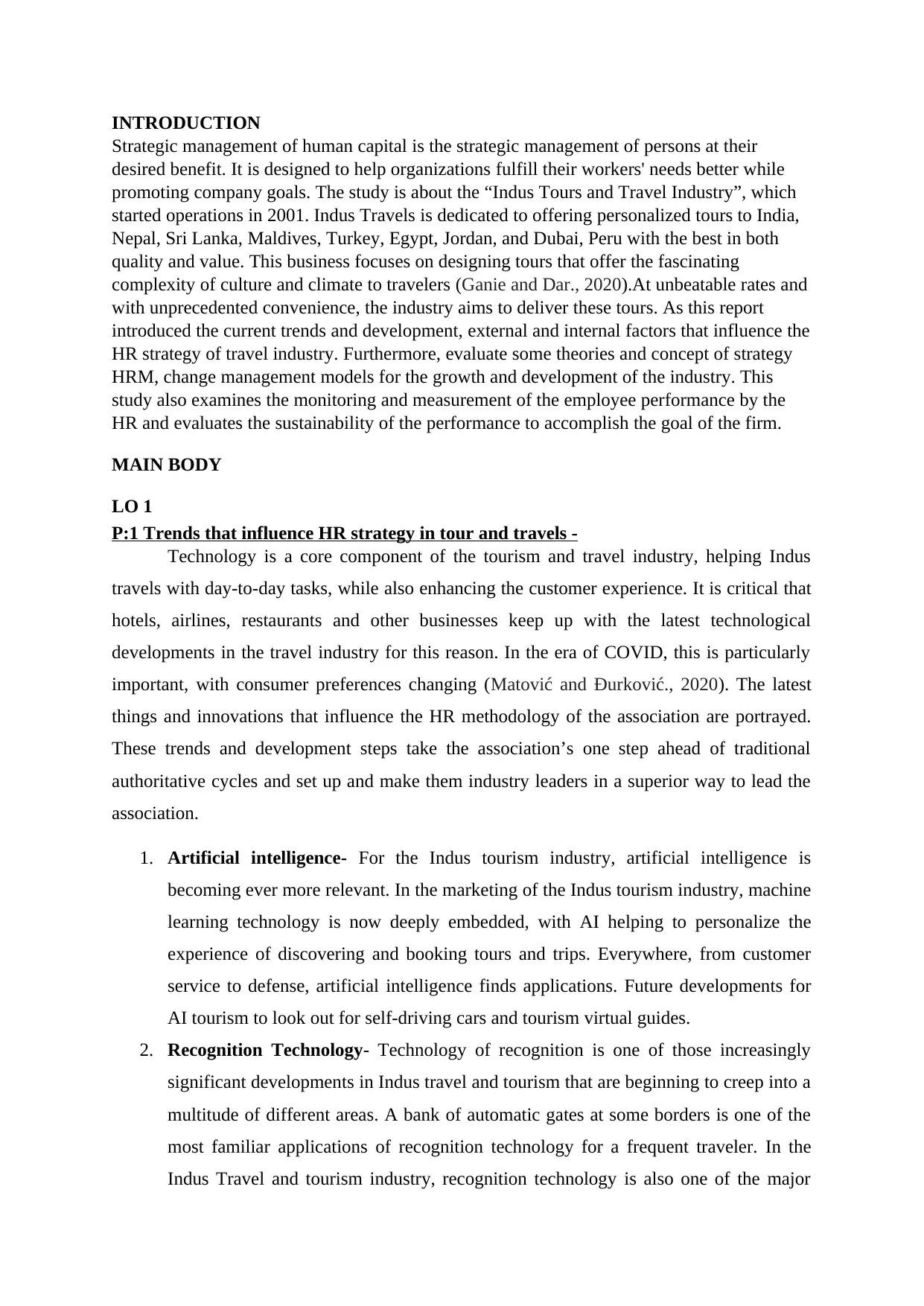
INTRODUCTION
Strategic management of human capital is the strategic management of persons at their
desired benefit. It is designed to help organizations fulfill their workers' needs better while
promoting company goals. The study is about the “Indus Tours and Travel Industry”, which
started operations in 2001. Indus Travels is dedicated to offering personalized tours to India,
Nepal, Sri Lanka, Maldives, Turkey, Egypt, Jordan, and Dubai, Peru with the best in both
quality and value. This business focuses on designing tours that offer the fascinating
complexity of culture and climate to travelers (Ganie and Dar., 2020).At unbeatable rates and
with unprecedented convenience, the industry aims to deliver these tours. As this report
introduced the current trends and development, external and internal factors that influence the
HR strategy of travel industry. Furthermore, evaluate some theories and concept of strategy
HRM, change management models for the growth and development of the industry. This
study also examines the monitoring and measurement of the employee performance by the
HR and evaluates the sustainability of the performance to accomplish the goal of the firm.
MAIN BODY
LO 1
P:1 Trends that influence HR strategy in tour and travels -
Technology is a core component of the tourism and travel industry, helping Indus
travels with day-to-day tasks, while also enhancing the customer experience. It is critical that
hotels, airlines, restaurants and other businesses keep up with the latest technological
developments in the travel industry for this reason. In the era of COVID, this is particularly
important, with consumer preferences changing (Matović and Đurković., 2020). The latest
things and innovations that influence the HR methodology of the association are portrayed.
These trends and development steps take the association’s one step ahead of traditional
authoritative cycles and set up and make them industry leaders in a superior way to lead the
association.
1. Artificial intelligence- For the Indus tourism industry, artificial intelligence is
becoming ever more relevant. In the marketing of the Indus tourism industry, machine
learning technology is now deeply embedded, with AI helping to personalize the
experience of discovering and booking tours and trips. Everywhere, from customer
service to defense, artificial intelligence finds applications. Future developments for
AI tourism to look out for self-driving cars and tourism virtual guides.
2. Recognition Technology- Technology of recognition is one of those increasingly
significant developments in Indus travel and tourism that are beginning to creep into a
multitude of different areas. A bank of automatic gates at some borders is one of the
most familiar applications of recognition technology for a frequent traveler. In the
Indus Travel and tourism industry, recognition technology is also one of the major
Strategic management of human capital is the strategic management of persons at their
desired benefit. It is designed to help organizations fulfill their workers' needs better while
promoting company goals. The study is about the “Indus Tours and Travel Industry”, which
started operations in 2001. Indus Travels is dedicated to offering personalized tours to India,
Nepal, Sri Lanka, Maldives, Turkey, Egypt, Jordan, and Dubai, Peru with the best in both
quality and value. This business focuses on designing tours that offer the fascinating
complexity of culture and climate to travelers (Ganie and Dar., 2020).At unbeatable rates and
with unprecedented convenience, the industry aims to deliver these tours. As this report
introduced the current trends and development, external and internal factors that influence the
HR strategy of travel industry. Furthermore, evaluate some theories and concept of strategy
HRM, change management models for the growth and development of the industry. This
study also examines the monitoring and measurement of the employee performance by the
HR and evaluates the sustainability of the performance to accomplish the goal of the firm.
MAIN BODY
LO 1
P:1 Trends that influence HR strategy in tour and travels -
Technology is a core component of the tourism and travel industry, helping Indus
travels with day-to-day tasks, while also enhancing the customer experience. It is critical that
hotels, airlines, restaurants and other businesses keep up with the latest technological
developments in the travel industry for this reason. In the era of COVID, this is particularly
important, with consumer preferences changing (Matović and Đurković., 2020). The latest
things and innovations that influence the HR methodology of the association are portrayed.
These trends and development steps take the association’s one step ahead of traditional
authoritative cycles and set up and make them industry leaders in a superior way to lead the
association.
1. Artificial intelligence- For the Indus tourism industry, artificial intelligence is
becoming ever more relevant. In the marketing of the Indus tourism industry, machine
learning technology is now deeply embedded, with AI helping to personalize the
experience of discovering and booking tours and trips. Everywhere, from customer
service to defense, artificial intelligence finds applications. Future developments for
AI tourism to look out for self-driving cars and tourism virtual guides.
2. Recognition Technology- Technology of recognition is one of those increasingly
significant developments in Indus travel and tourism that are beginning to creep into a
multitude of different areas. A bank of automatic gates at some borders is one of the
most familiar applications of recognition technology for a frequent traveler. In the
Indus Travel and tourism industry, recognition technology is also one of the major
⊘ This is a preview!⊘
Do you want full access?
Subscribe today to unlock all pages.

Trusted by 1+ million students worldwide
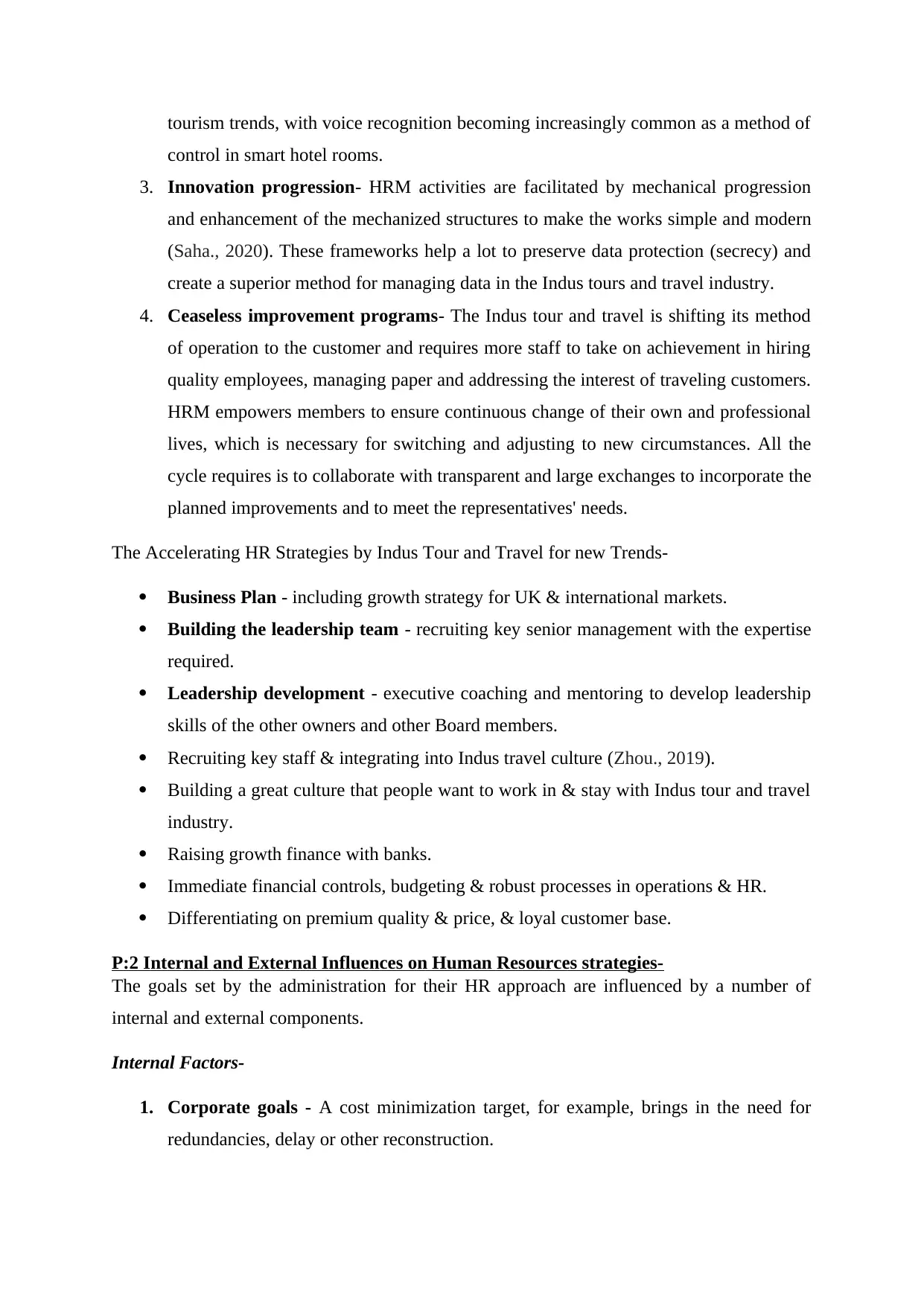
tourism trends, with voice recognition becoming increasingly common as a method of
control in smart hotel rooms.
3. Innovation progression- HRM activities are facilitated by mechanical progression
and enhancement of the mechanized structures to make the works simple and modern
(Saha., 2020). These frameworks help a lot to preserve data protection (secrecy) and
create a superior method for managing data in the Indus tours and travel industry.
4. Ceaseless improvement programs- The Indus tour and travel is shifting its method
of operation to the customer and requires more staff to take on achievement in hiring
quality employees, managing paper and addressing the interest of traveling customers.
HRM empowers members to ensure continuous change of their own and professional
lives, which is necessary for switching and adjusting to new circumstances. All the
cycle requires is to collaborate with transparent and large exchanges to incorporate the
planned improvements and to meet the representatives' needs.
The Accelerating HR Strategies by Indus Tour and Travel for new Trends-
Business Plan - including growth strategy for UK & international markets.
Building the leadership team - recruiting key senior management with the expertise
required.
Leadership development - executive coaching and mentoring to develop leadership
skills of the other owners and other Board members.
Recruiting key staff & integrating into Indus travel culture (Zhou., 2019).
Building a great culture that people want to work in & stay with Indus tour and travel
industry.
Raising growth finance with banks.
Immediate financial controls, budgeting & robust processes in operations & HR.
Differentiating on premium quality & price, & loyal customer base.
P:2 Internal and External Influences on Human Resources strategies-
The goals set by the administration for their HR approach are influenced by a number of
internal and external components.
Internal Factors-
1. Corporate goals - A cost minimization target, for example, brings in the need for
redundancies, delay or other reconstruction.
control in smart hotel rooms.
3. Innovation progression- HRM activities are facilitated by mechanical progression
and enhancement of the mechanized structures to make the works simple and modern
(Saha., 2020). These frameworks help a lot to preserve data protection (secrecy) and
create a superior method for managing data in the Indus tours and travel industry.
4. Ceaseless improvement programs- The Indus tour and travel is shifting its method
of operation to the customer and requires more staff to take on achievement in hiring
quality employees, managing paper and addressing the interest of traveling customers.
HRM empowers members to ensure continuous change of their own and professional
lives, which is necessary for switching and adjusting to new circumstances. All the
cycle requires is to collaborate with transparent and large exchanges to incorporate the
planned improvements and to meet the representatives' needs.
The Accelerating HR Strategies by Indus Tour and Travel for new Trends-
Business Plan - including growth strategy for UK & international markets.
Building the leadership team - recruiting key senior management with the expertise
required.
Leadership development - executive coaching and mentoring to develop leadership
skills of the other owners and other Board members.
Recruiting key staff & integrating into Indus travel culture (Zhou., 2019).
Building a great culture that people want to work in & stay with Indus tour and travel
industry.
Raising growth finance with banks.
Immediate financial controls, budgeting & robust processes in operations & HR.
Differentiating on premium quality & price, & loyal customer base.
P:2 Internal and External Influences on Human Resources strategies-
The goals set by the administration for their HR approach are influenced by a number of
internal and external components.
Internal Factors-
1. Corporate goals - A cost minimization target, for example, brings in the need for
redundancies, delay or other reconstruction.
Paraphrase This Document
Need a fresh take? Get an instant paraphrase of this document with our AI Paraphraser
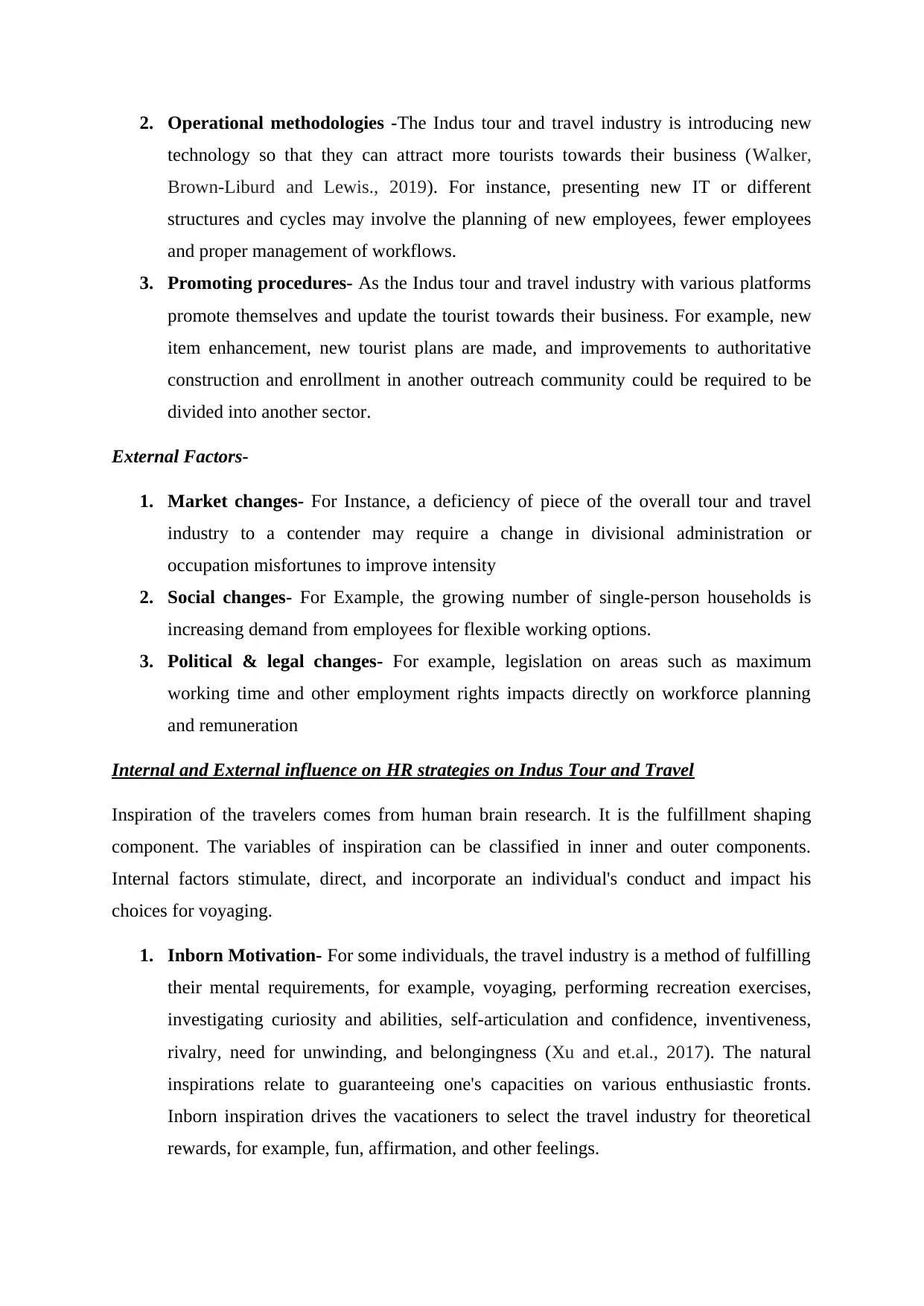
2. Operational methodologies -The Indus tour and travel industry is introducing new
technology so that they can attract more tourists towards their business (Walker,
Brown-Liburd and Lewis., 2019). For instance, presenting new IT or different
structures and cycles may involve the planning of new employees, fewer employees
and proper management of workflows.
3. Promoting procedures- As the Indus tour and travel industry with various platforms
promote themselves and update the tourist towards their business. For example, new
item enhancement, new tourist plans are made, and improvements to authoritative
construction and enrollment in another outreach community could be required to be
divided into another sector.
External Factors-
1. Market changes- For Instance, a deficiency of piece of the overall tour and travel
industry to a contender may require a change in divisional administration or
occupation misfortunes to improve intensity
2. Social changes- For Example, the growing number of single-person households is
increasing demand from employees for flexible working options.
3. Political & legal changes- For example, legislation on areas such as maximum
working time and other employment rights impacts directly on workforce planning
and remuneration
Internal and External influence on HR strategies on Indus Tour and Travel
Inspiration of the travelers comes from human brain research. It is the fulfillment shaping
component. The variables of inspiration can be classified in inner and outer components.
Internal factors stimulate, direct, and incorporate an individual's conduct and impact his
choices for voyaging.
1. Inborn Motivation- For some individuals, the travel industry is a method of fulfilling
their mental requirements, for example, voyaging, performing recreation exercises,
investigating curiosity and abilities, self-articulation and confidence, inventiveness,
rivalry, need for unwinding, and belongingness (Xu and et.al., 2017). The natural
inspirations relate to guaranteeing one's capacities on various enthusiastic fronts.
Inborn inspiration drives the vacationers to select the travel industry for theoretical
rewards, for example, fun, affirmation, and other feelings.
technology so that they can attract more tourists towards their business (Walker,
Brown-Liburd and Lewis., 2019). For instance, presenting new IT or different
structures and cycles may involve the planning of new employees, fewer employees
and proper management of workflows.
3. Promoting procedures- As the Indus tour and travel industry with various platforms
promote themselves and update the tourist towards their business. For example, new
item enhancement, new tourist plans are made, and improvements to authoritative
construction and enrollment in another outreach community could be required to be
divided into another sector.
External Factors-
1. Market changes- For Instance, a deficiency of piece of the overall tour and travel
industry to a contender may require a change in divisional administration or
occupation misfortunes to improve intensity
2. Social changes- For Example, the growing number of single-person households is
increasing demand from employees for flexible working options.
3. Political & legal changes- For example, legislation on areas such as maximum
working time and other employment rights impacts directly on workforce planning
and remuneration
Internal and External influence on HR strategies on Indus Tour and Travel
Inspiration of the travelers comes from human brain research. It is the fulfillment shaping
component. The variables of inspiration can be classified in inner and outer components.
Internal factors stimulate, direct, and incorporate an individual's conduct and impact his
choices for voyaging.
1. Inborn Motivation- For some individuals, the travel industry is a method of fulfilling
their mental requirements, for example, voyaging, performing recreation exercises,
investigating curiosity and abilities, self-articulation and confidence, inventiveness,
rivalry, need for unwinding, and belongingness (Xu and et.al., 2017). The natural
inspirations relate to guaranteeing one's capacities on various enthusiastic fronts.
Inborn inspiration drives the vacationers to select the travel industry for theoretical
rewards, for example, fun, affirmation, and other feelings.
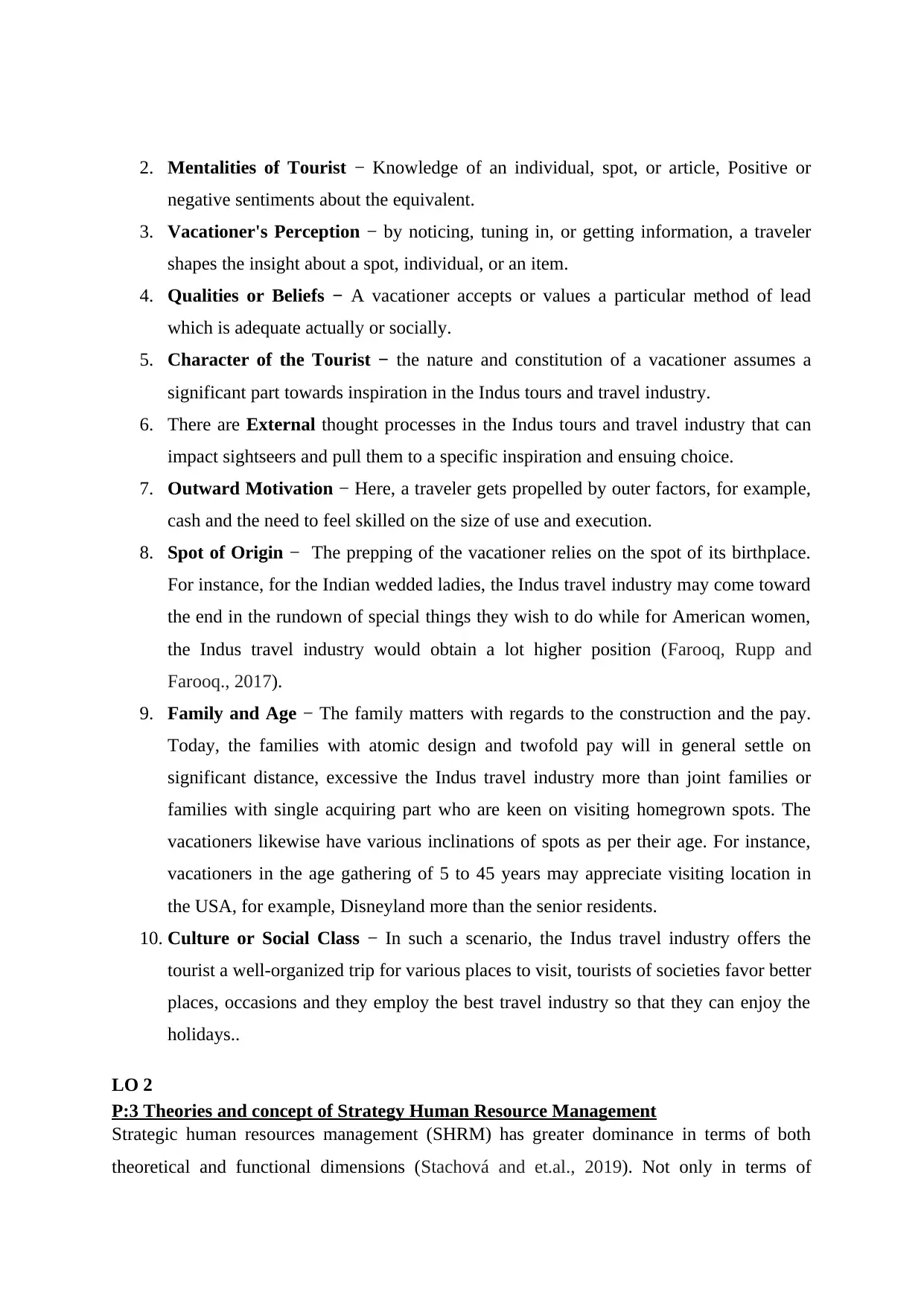
2. Mentalities of Tourist − Knowledge of an individual, spot, or article, Positive or
negative sentiments about the equivalent.
3. Vacationer's Perception − by noticing, tuning in, or getting information, a traveler
shapes the insight about a spot, individual, or an item.
4. Qualities or Beliefs − A vacationer accepts or values a particular method of lead
which is adequate actually or socially.
5. Character of the Tourist − the nature and constitution of a vacationer assumes a
significant part towards inspiration in the Indus tours and travel industry.
6. There are External thought processes in the Indus tours and travel industry that can
impact sightseers and pull them to a specific inspiration and ensuing choice.
7. Outward Motivation − Here, a traveler gets propelled by outer factors, for example,
cash and the need to feel skilled on the size of use and execution.
8. Spot of Origin − The prepping of the vacationer relies on the spot of its birthplace.
For instance, for the Indian wedded ladies, the Indus travel industry may come toward
the end in the rundown of special things they wish to do while for American women,
the Indus travel industry would obtain a lot higher position (Farooq, Rupp and
Farooq., 2017).
9. Family and Age − The family matters with regards to the construction and the pay.
Today, the families with atomic design and twofold pay will in general settle on
significant distance, excessive the Indus travel industry more than joint families or
families with single acquiring part who are keen on visiting homegrown spots. The
vacationers likewise have various inclinations of spots as per their age. For instance,
vacationers in the age gathering of 5 to 45 years may appreciate visiting location in
the USA, for example, Disneyland more than the senior residents.
10. Culture or Social Class − In such a scenario, the Indus travel industry offers the
tourist a well-organized trip for various places to visit, tourists of societies favor better
places, occasions and they employ the best travel industry so that they can enjoy the
holidays..
LO 2
P:3 Theories and concept of Strategy Human Resource Management
Strategic human resources management (SHRM) has greater dominance in terms of both
theoretical and functional dimensions (Stachová and et.al., 2019). Not only in terms of
negative sentiments about the equivalent.
3. Vacationer's Perception − by noticing, tuning in, or getting information, a traveler
shapes the insight about a spot, individual, or an item.
4. Qualities or Beliefs − A vacationer accepts or values a particular method of lead
which is adequate actually or socially.
5. Character of the Tourist − the nature and constitution of a vacationer assumes a
significant part towards inspiration in the Indus tours and travel industry.
6. There are External thought processes in the Indus tours and travel industry that can
impact sightseers and pull them to a specific inspiration and ensuing choice.
7. Outward Motivation − Here, a traveler gets propelled by outer factors, for example,
cash and the need to feel skilled on the size of use and execution.
8. Spot of Origin − The prepping of the vacationer relies on the spot of its birthplace.
For instance, for the Indian wedded ladies, the Indus travel industry may come toward
the end in the rundown of special things they wish to do while for American women,
the Indus travel industry would obtain a lot higher position (Farooq, Rupp and
Farooq., 2017).
9. Family and Age − The family matters with regards to the construction and the pay.
Today, the families with atomic design and twofold pay will in general settle on
significant distance, excessive the Indus travel industry more than joint families or
families with single acquiring part who are keen on visiting homegrown spots. The
vacationers likewise have various inclinations of spots as per their age. For instance,
vacationers in the age gathering of 5 to 45 years may appreciate visiting location in
the USA, for example, Disneyland more than the senior residents.
10. Culture or Social Class − In such a scenario, the Indus travel industry offers the
tourist a well-organized trip for various places to visit, tourists of societies favor better
places, occasions and they employ the best travel industry so that they can enjoy the
holidays..
LO 2
P:3 Theories and concept of Strategy Human Resource Management
Strategic human resources management (SHRM) has greater dominance in terms of both
theoretical and functional dimensions (Stachová and et.al., 2019). Not only in terms of
⊘ This is a preview!⊘
Do you want full access?
Subscribe today to unlock all pages.

Trusted by 1+ million students worldwide
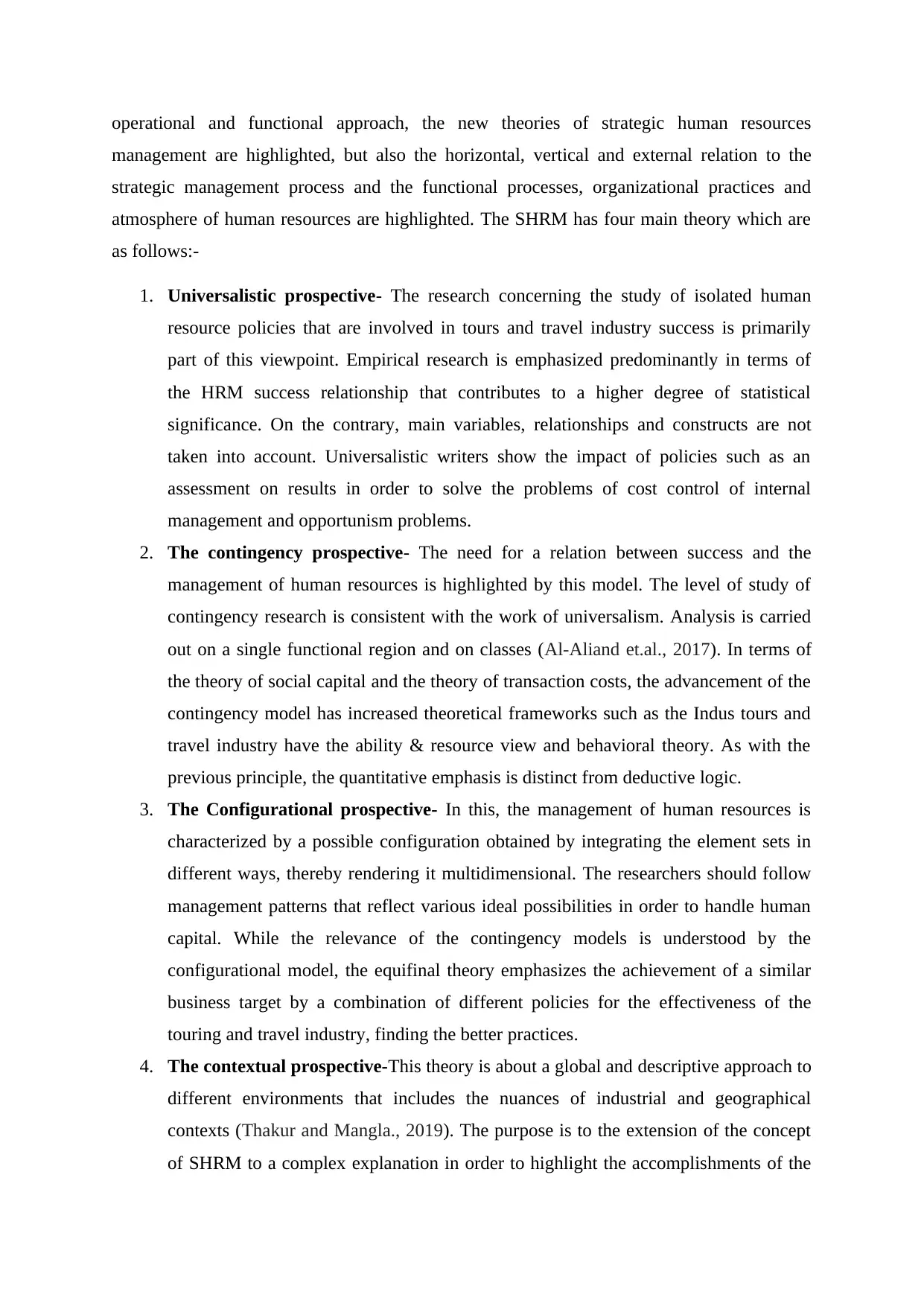
operational and functional approach, the new theories of strategic human resources
management are highlighted, but also the horizontal, vertical and external relation to the
strategic management process and the functional processes, organizational practices and
atmosphere of human resources are highlighted. The SHRM has four main theory which are
as follows:-
1. Universalistic prospective- The research concerning the study of isolated human
resource policies that are involved in tours and travel industry success is primarily
part of this viewpoint. Empirical research is emphasized predominantly in terms of
the HRM success relationship that contributes to a higher degree of statistical
significance. On the contrary, main variables, relationships and constructs are not
taken into account. Universalistic writers show the impact of policies such as an
assessment on results in order to solve the problems of cost control of internal
management and opportunism problems.
2. The contingency prospective- The need for a relation between success and the
management of human resources is highlighted by this model. The level of study of
contingency research is consistent with the work of universalism. Analysis is carried
out on a single functional region and on classes (Al-Aliand et.al., 2017). In terms of
the theory of social capital and the theory of transaction costs, the advancement of the
contingency model has increased theoretical frameworks such as the Indus tours and
travel industry have the ability & resource view and behavioral theory. As with the
previous principle, the quantitative emphasis is distinct from deductive logic.
3. The Configurational prospective- In this, the management of human resources is
characterized by a possible configuration obtained by integrating the element sets in
different ways, thereby rendering it multidimensional. The researchers should follow
management patterns that reflect various ideal possibilities in order to handle human
capital. While the relevance of the contingency models is understood by the
configurational model, the equifinal theory emphasizes the achievement of a similar
business target by a combination of different policies for the effectiveness of the
touring and travel industry, finding the better practices.
4. The contextual prospective-This theory is about a global and descriptive approach to
different environments that includes the nuances of industrial and geographical
contexts (Thakur and Mangla., 2019). The purpose is to the extension of the concept
of SHRM to a complex explanation in order to highlight the accomplishments of the
management are highlighted, but also the horizontal, vertical and external relation to the
strategic management process and the functional processes, organizational practices and
atmosphere of human resources are highlighted. The SHRM has four main theory which are
as follows:-
1. Universalistic prospective- The research concerning the study of isolated human
resource policies that are involved in tours and travel industry success is primarily
part of this viewpoint. Empirical research is emphasized predominantly in terms of
the HRM success relationship that contributes to a higher degree of statistical
significance. On the contrary, main variables, relationships and constructs are not
taken into account. Universalistic writers show the impact of policies such as an
assessment on results in order to solve the problems of cost control of internal
management and opportunism problems.
2. The contingency prospective- The need for a relation between success and the
management of human resources is highlighted by this model. The level of study of
contingency research is consistent with the work of universalism. Analysis is carried
out on a single functional region and on classes (Al-Aliand et.al., 2017). In terms of
the theory of social capital and the theory of transaction costs, the advancement of the
contingency model has increased theoretical frameworks such as the Indus tours and
travel industry have the ability & resource view and behavioral theory. As with the
previous principle, the quantitative emphasis is distinct from deductive logic.
3. The Configurational prospective- In this, the management of human resources is
characterized by a possible configuration obtained by integrating the element sets in
different ways, thereby rendering it multidimensional. The researchers should follow
management patterns that reflect various ideal possibilities in order to handle human
capital. While the relevance of the contingency models is understood by the
configurational model, the equifinal theory emphasizes the achievement of a similar
business target by a combination of different policies for the effectiveness of the
touring and travel industry, finding the better practices.
4. The contextual prospective-This theory is about a global and descriptive approach to
different environments that includes the nuances of industrial and geographical
contexts (Thakur and Mangla., 2019). The purpose is to the extension of the concept
of SHRM to a complex explanation in order to highlight the accomplishments of the
Paraphrase This Document
Need a fresh take? Get an instant paraphrase of this document with our AI Paraphraser
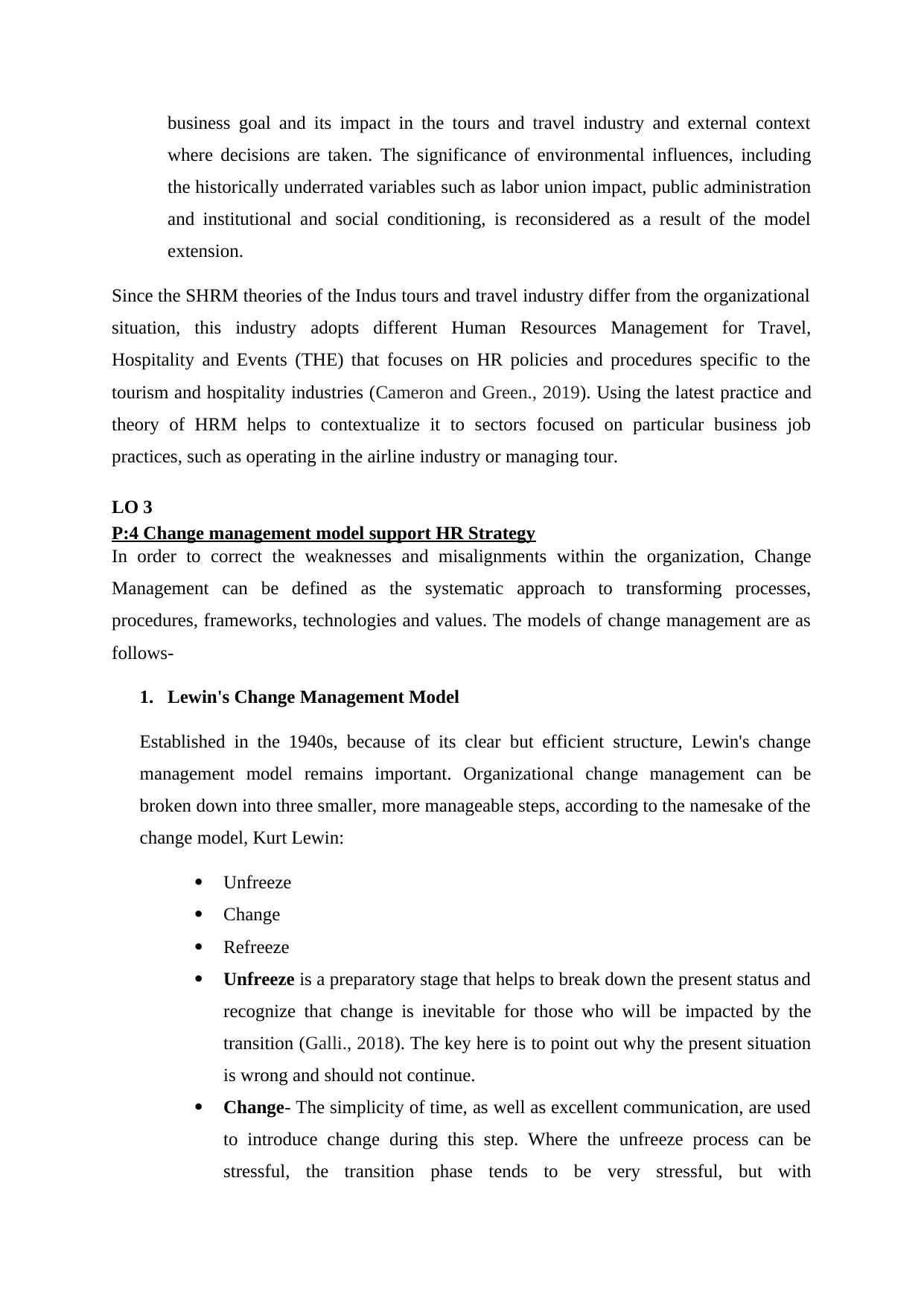
business goal and its impact in the tours and travel industry and external context
where decisions are taken. The significance of environmental influences, including
the historically underrated variables such as labor union impact, public administration
and institutional and social conditioning, is reconsidered as a result of the model
extension.
Since the SHRM theories of the Indus tours and travel industry differ from the organizational
situation, this industry adopts different Human Resources Management for Travel,
Hospitality and Events (THE) that focuses on HR policies and procedures specific to the
tourism and hospitality industries (Cameron and Green., 2019). Using the latest practice and
theory of HRM helps to contextualize it to sectors focused on particular business job
practices, such as operating in the airline industry or managing tour.
LO 3
P:4 Change management model support HR Strategy
In order to correct the weaknesses and misalignments within the organization, Change
Management can be defined as the systematic approach to transforming processes,
procedures, frameworks, technologies and values. The models of change management are as
follows-
1. Lewin's Change Management Model
Established in the 1940s, because of its clear but efficient structure, Lewin's change
management model remains important. Organizational change management can be
broken down into three smaller, more manageable steps, according to the namesake of the
change model, Kurt Lewin:
Unfreeze
Change
Refreeze
Unfreeze is a preparatory stage that helps to break down the present status and
recognize that change is inevitable for those who will be impacted by the
transition (Galli., 2018). The key here is to point out why the present situation
is wrong and should not continue.
Change- The simplicity of time, as well as excellent communication, are used
to introduce change during this step. Where the unfreeze process can be
stressful, the transition phase tends to be very stressful, but with
where decisions are taken. The significance of environmental influences, including
the historically underrated variables such as labor union impact, public administration
and institutional and social conditioning, is reconsidered as a result of the model
extension.
Since the SHRM theories of the Indus tours and travel industry differ from the organizational
situation, this industry adopts different Human Resources Management for Travel,
Hospitality and Events (THE) that focuses on HR policies and procedures specific to the
tourism and hospitality industries (Cameron and Green., 2019). Using the latest practice and
theory of HRM helps to contextualize it to sectors focused on particular business job
practices, such as operating in the airline industry or managing tour.
LO 3
P:4 Change management model support HR Strategy
In order to correct the weaknesses and misalignments within the organization, Change
Management can be defined as the systematic approach to transforming processes,
procedures, frameworks, technologies and values. The models of change management are as
follows-
1. Lewin's Change Management Model
Established in the 1940s, because of its clear but efficient structure, Lewin's change
management model remains important. Organizational change management can be
broken down into three smaller, more manageable steps, according to the namesake of the
change model, Kurt Lewin:
Unfreeze
Change
Refreeze
Unfreeze is a preparatory stage that helps to break down the present status and
recognize that change is inevitable for those who will be impacted by the
transition (Galli., 2018). The key here is to point out why the present situation
is wrong and should not continue.
Change- The simplicity of time, as well as excellent communication, are used
to introduce change during this step. Where the unfreeze process can be
stressful, the transition phase tends to be very stressful, but with
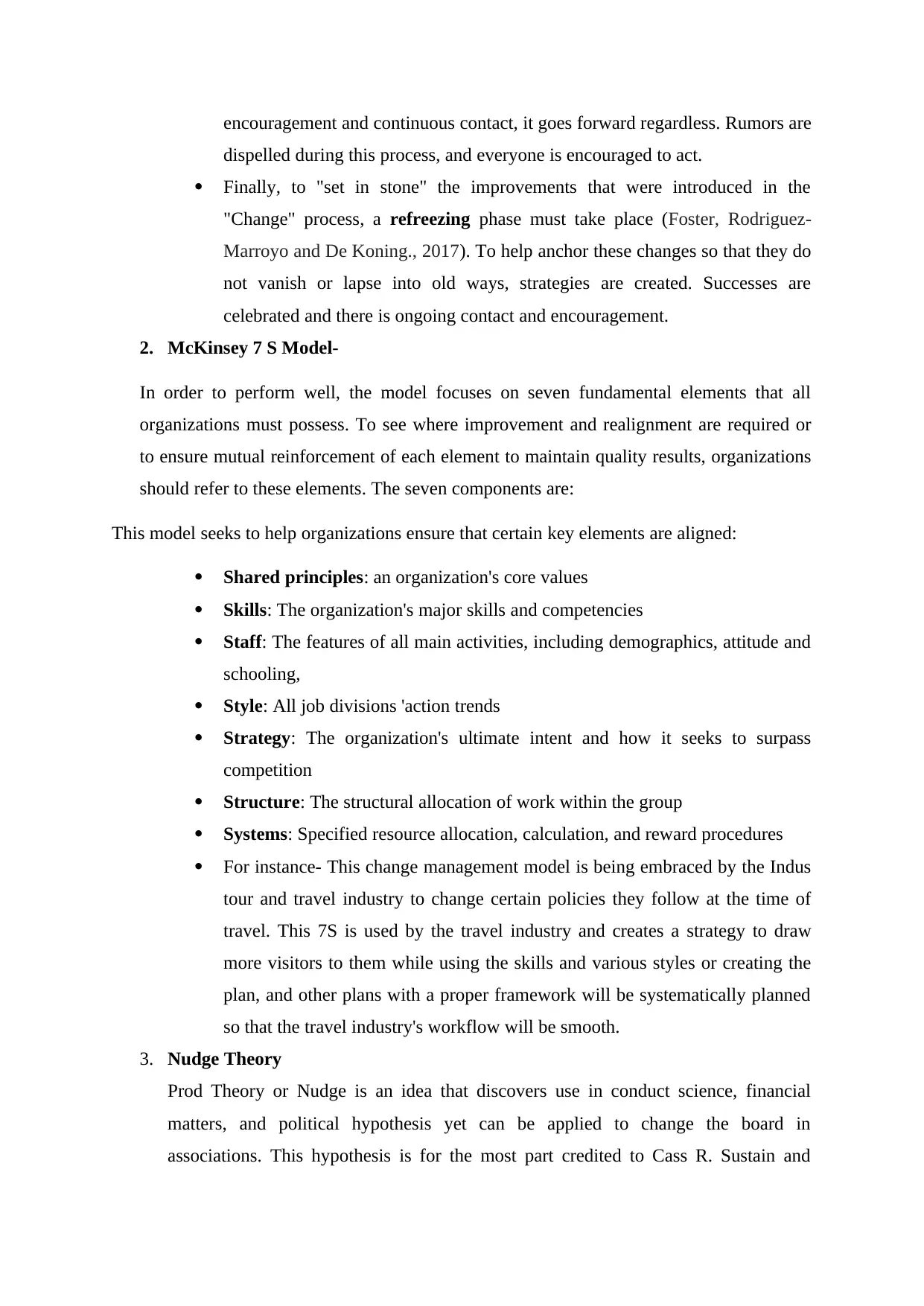
encouragement and continuous contact, it goes forward regardless. Rumors are
dispelled during this process, and everyone is encouraged to act.
Finally, to "set in stone" the improvements that were introduced in the
"Change" process, a refreezing phase must take place (Foster, Rodriguez-
Marroyo and De Koning., 2017). To help anchor these changes so that they do
not vanish or lapse into old ways, strategies are created. Successes are
celebrated and there is ongoing contact and encouragement.
2. McKinsey 7 S Model-
In order to perform well, the model focuses on seven fundamental elements that all
organizations must possess. To see where improvement and realignment are required or
to ensure mutual reinforcement of each element to maintain quality results, organizations
should refer to these elements. The seven components are:
This model seeks to help organizations ensure that certain key elements are aligned:
Shared principles: an organization's core values
Skills: The organization's major skills and competencies
Staff: The features of all main activities, including demographics, attitude and
schooling,
Style: All job divisions 'action trends
Strategy: The organization's ultimate intent and how it seeks to surpass
competition
Structure: The structural allocation of work within the group
Systems: Specified resource allocation, calculation, and reward procedures
For instance- This change management model is being embraced by the Indus
tour and travel industry to change certain policies they follow at the time of
travel. This 7S is used by the travel industry and creates a strategy to draw
more visitors to them while using the skills and various styles or creating the
plan, and other plans with a proper framework will be systematically planned
so that the travel industry's workflow will be smooth.
3. Nudge Theory
Prod Theory or Nudge is an idea that discovers use in conduct science, financial
matters, and political hypothesis yet can be applied to change the board in
associations. This hypothesis is for the most part credited to Cass R. Sustain and
dispelled during this process, and everyone is encouraged to act.
Finally, to "set in stone" the improvements that were introduced in the
"Change" process, a refreezing phase must take place (Foster, Rodriguez-
Marroyo and De Koning., 2017). To help anchor these changes so that they do
not vanish or lapse into old ways, strategies are created. Successes are
celebrated and there is ongoing contact and encouragement.
2. McKinsey 7 S Model-
In order to perform well, the model focuses on seven fundamental elements that all
organizations must possess. To see where improvement and realignment are required or
to ensure mutual reinforcement of each element to maintain quality results, organizations
should refer to these elements. The seven components are:
This model seeks to help organizations ensure that certain key elements are aligned:
Shared principles: an organization's core values
Skills: The organization's major skills and competencies
Staff: The features of all main activities, including demographics, attitude and
schooling,
Style: All job divisions 'action trends
Strategy: The organization's ultimate intent and how it seeks to surpass
competition
Structure: The structural allocation of work within the group
Systems: Specified resource allocation, calculation, and reward procedures
For instance- This change management model is being embraced by the Indus
tour and travel industry to change certain policies they follow at the time of
travel. This 7S is used by the travel industry and creates a strategy to draw
more visitors to them while using the skills and various styles or creating the
plan, and other plans with a proper framework will be systematically planned
so that the travel industry's workflow will be smooth.
3. Nudge Theory
Prod Theory or Nudge is an idea that discovers use in conduct science, financial
matters, and political hypothesis yet can be applied to change the board in
associations. This hypothesis is for the most part credited to Cass R. Sustain and
⊘ This is a preview!⊘
Do you want full access?
Subscribe today to unlock all pages.

Trusted by 1+ million students worldwide
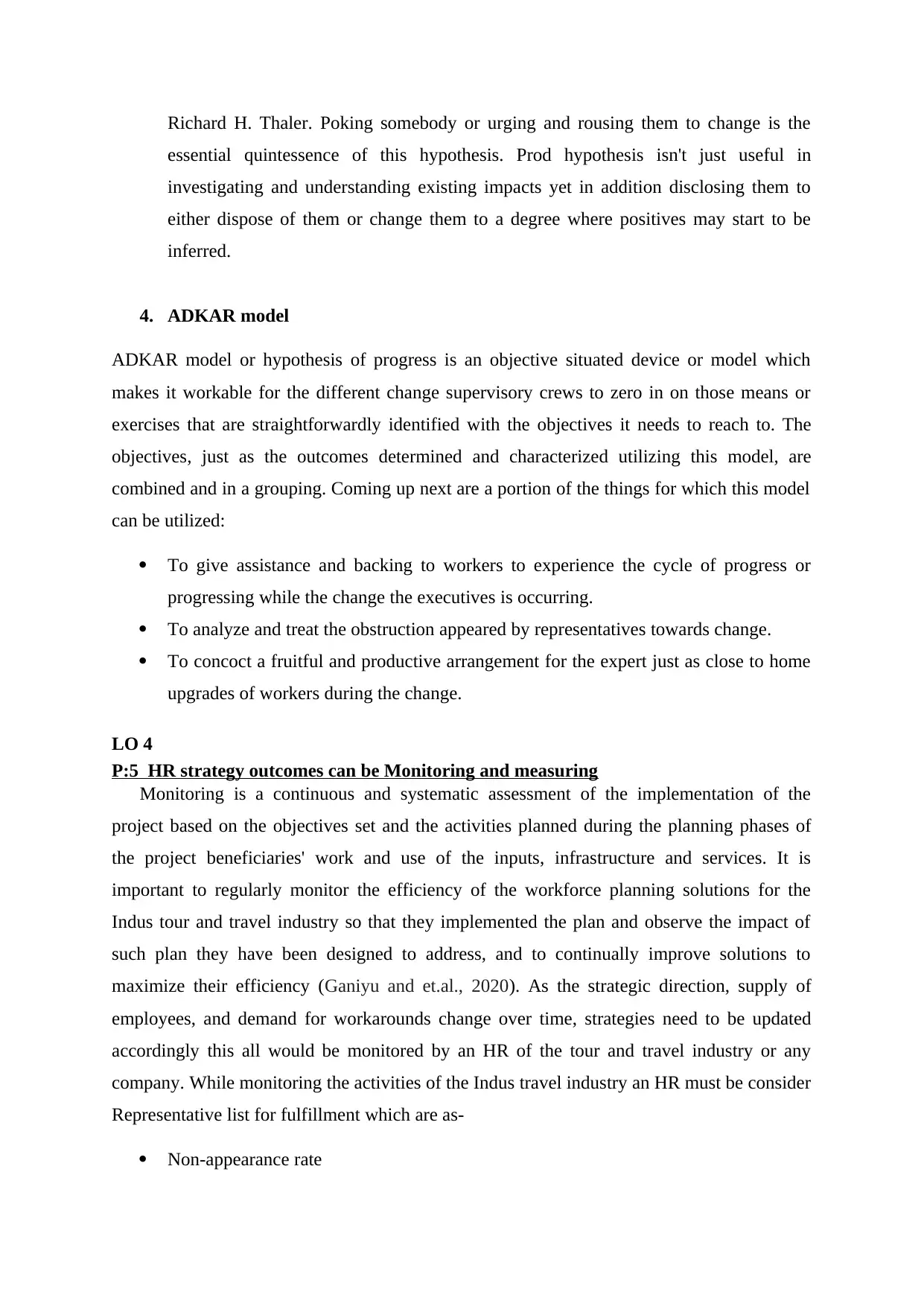
Richard H. Thaler. Poking somebody or urging and rousing them to change is the
essential quintessence of this hypothesis. Prod hypothesis isn't just useful in
investigating and understanding existing impacts yet in addition disclosing them to
either dispose of them or change them to a degree where positives may start to be
inferred.
4. ADKAR model
ADKAR model or hypothesis of progress is an objective situated device or model which
makes it workable for the different change supervisory crews to zero in on those means or
exercises that are straightforwardly identified with the objectives it needs to reach to. The
objectives, just as the outcomes determined and characterized utilizing this model, are
combined and in a grouping. Coming up next are a portion of the things for which this model
can be utilized:
To give assistance and backing to workers to experience the cycle of progress or
progressing while the change the executives is occurring.
To analyze and treat the obstruction appeared by representatives towards change.
To concoct a fruitful and productive arrangement for the expert just as close to home
upgrades of workers during the change.
LO 4
P:5 HR strategy outcomes can be Monitoring and measuring
Monitoring is a continuous and systematic assessment of the implementation of the
project based on the objectives set and the activities planned during the planning phases of
the project beneficiaries' work and use of the inputs, infrastructure and services. It is
important to regularly monitor the efficiency of the workforce planning solutions for the
Indus tour and travel industry so that they implemented the plan and observe the impact of
such plan they have been designed to address, and to continually improve solutions to
maximize their efficiency (Ganiyu and et.al., 2020). As the strategic direction, supply of
employees, and demand for workarounds change over time, strategies need to be updated
accordingly this all would be monitored by an HR of the tour and travel industry or any
company. While monitoring the activities of the Indus travel industry an HR must be consider
Representative list for fulfillment which are as-
Non-appearance rate
essential quintessence of this hypothesis. Prod hypothesis isn't just useful in
investigating and understanding existing impacts yet in addition disclosing them to
either dispose of them or change them to a degree where positives may start to be
inferred.
4. ADKAR model
ADKAR model or hypothesis of progress is an objective situated device or model which
makes it workable for the different change supervisory crews to zero in on those means or
exercises that are straightforwardly identified with the objectives it needs to reach to. The
objectives, just as the outcomes determined and characterized utilizing this model, are
combined and in a grouping. Coming up next are a portion of the things for which this model
can be utilized:
To give assistance and backing to workers to experience the cycle of progress or
progressing while the change the executives is occurring.
To analyze and treat the obstruction appeared by representatives towards change.
To concoct a fruitful and productive arrangement for the expert just as close to home
upgrades of workers during the change.
LO 4
P:5 HR strategy outcomes can be Monitoring and measuring
Monitoring is a continuous and systematic assessment of the implementation of the
project based on the objectives set and the activities planned during the planning phases of
the project beneficiaries' work and use of the inputs, infrastructure and services. It is
important to regularly monitor the efficiency of the workforce planning solutions for the
Indus tour and travel industry so that they implemented the plan and observe the impact of
such plan they have been designed to address, and to continually improve solutions to
maximize their efficiency (Ganiyu and et.al., 2020). As the strategic direction, supply of
employees, and demand for workarounds change over time, strategies need to be updated
accordingly this all would be monitored by an HR of the tour and travel industry or any
company. While monitoring the activities of the Indus travel industry an HR must be consider
Representative list for fulfillment which are as-
Non-appearance rate
Paraphrase This Document
Need a fresh take? Get an instant paraphrase of this document with our AI Paraphraser
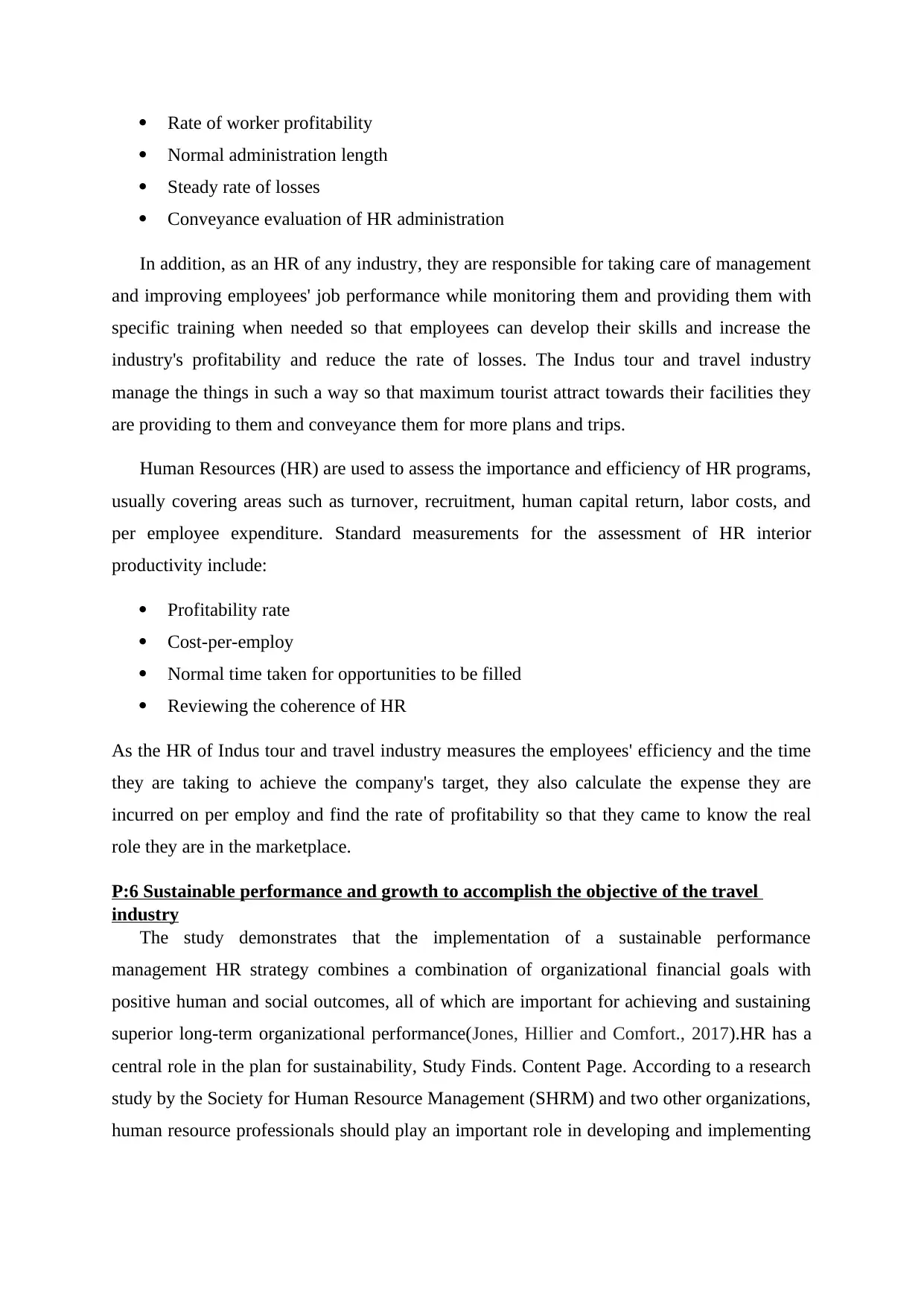
Rate of worker profitability
Normal administration length
Steady rate of losses
Conveyance evaluation of HR administration
In addition, as an HR of any industry, they are responsible for taking care of management
and improving employees' job performance while monitoring them and providing them with
specific training when needed so that employees can develop their skills and increase the
industry's profitability and reduce the rate of losses. The Indus tour and travel industry
manage the things in such a way so that maximum tourist attract towards their facilities they
are providing to them and conveyance them for more plans and trips.
Human Resources (HR) are used to assess the importance and efficiency of HR programs,
usually covering areas such as turnover, recruitment, human capital return, labor costs, and
per employee expenditure. Standard measurements for the assessment of HR interior
productivity include:
Profitability rate
Cost-per-employ
Normal time taken for opportunities to be filled
Reviewing the coherence of HR
As the HR of Indus tour and travel industry measures the employees' efficiency and the time
they are taking to achieve the company's target, they also calculate the expense they are
incurred on per employ and find the rate of profitability so that they came to know the real
role they are in the marketplace.
P:6 Sustainable performance and growth to accomplish the objective of the travel
industry
The study demonstrates that the implementation of a sustainable performance
management HR strategy combines a combination of organizational financial goals with
positive human and social outcomes, all of which are important for achieving and sustaining
superior long-term organizational performance(Jones, Hillier and Comfort., 2017).HR has a
central role in the plan for sustainability, Study Finds. Content Page. According to a research
study by the Society for Human Resource Management (SHRM) and two other organizations,
human resource professionals should play an important role in developing and implementing
Normal administration length
Steady rate of losses
Conveyance evaluation of HR administration
In addition, as an HR of any industry, they are responsible for taking care of management
and improving employees' job performance while monitoring them and providing them with
specific training when needed so that employees can develop their skills and increase the
industry's profitability and reduce the rate of losses. The Indus tour and travel industry
manage the things in such a way so that maximum tourist attract towards their facilities they
are providing to them and conveyance them for more plans and trips.
Human Resources (HR) are used to assess the importance and efficiency of HR programs,
usually covering areas such as turnover, recruitment, human capital return, labor costs, and
per employee expenditure. Standard measurements for the assessment of HR interior
productivity include:
Profitability rate
Cost-per-employ
Normal time taken for opportunities to be filled
Reviewing the coherence of HR
As the HR of Indus tour and travel industry measures the employees' efficiency and the time
they are taking to achieve the company's target, they also calculate the expense they are
incurred on per employ and find the rate of profitability so that they came to know the real
role they are in the marketplace.
P:6 Sustainable performance and growth to accomplish the objective of the travel
industry
The study demonstrates that the implementation of a sustainable performance
management HR strategy combines a combination of organizational financial goals with
positive human and social outcomes, all of which are important for achieving and sustaining
superior long-term organizational performance(Jones, Hillier and Comfort., 2017).HR has a
central role in the plan for sustainability, Study Finds. Content Page. According to a research
study by the Society for Human Resource Management (SHRM) and two other organizations,
human resource professionals should play an important role in developing and implementing
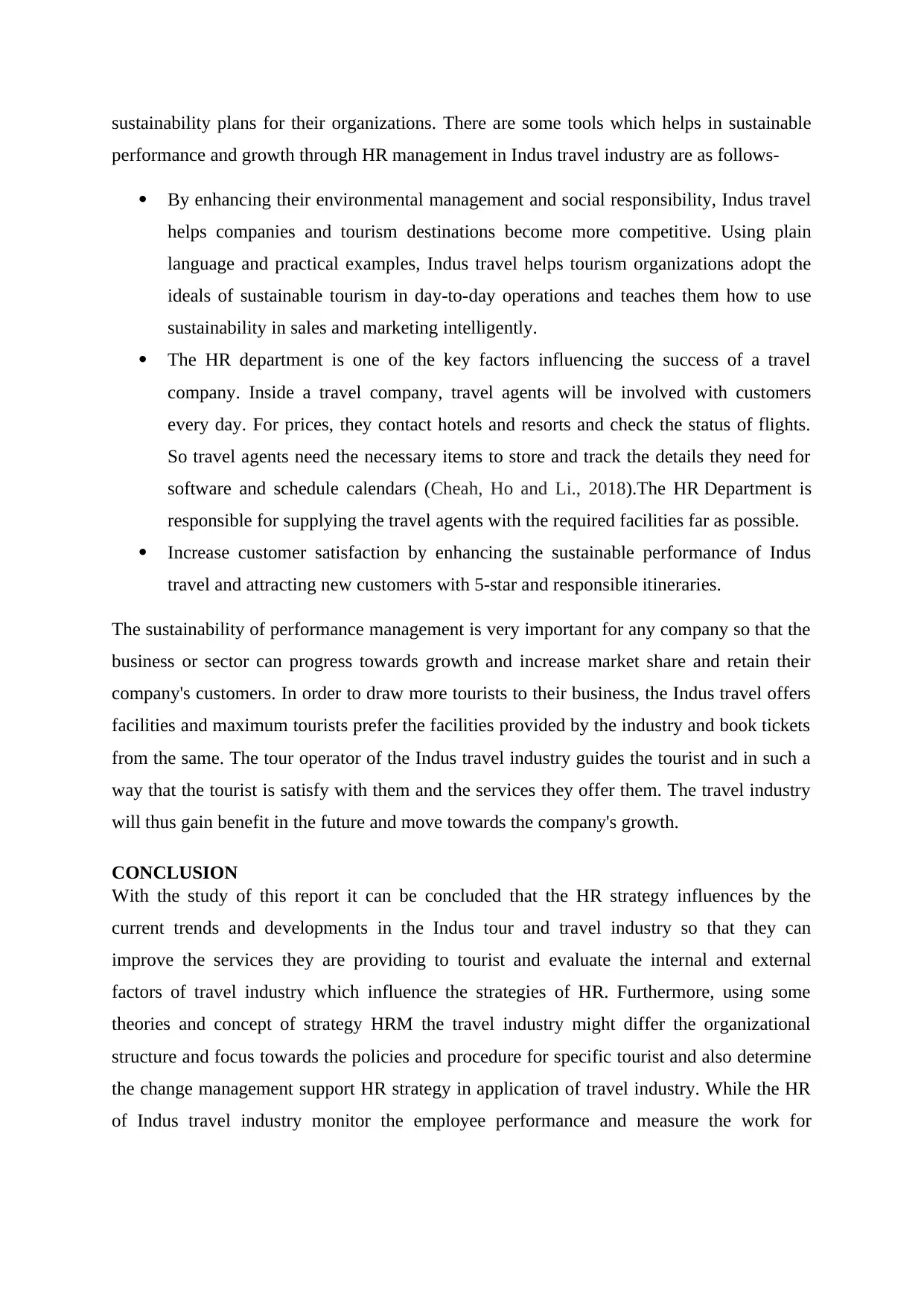
sustainability plans for their organizations. There are some tools which helps in sustainable
performance and growth through HR management in Indus travel industry are as follows-
By enhancing their environmental management and social responsibility, Indus travel
helps companies and tourism destinations become more competitive. Using plain
language and practical examples, Indus travel helps tourism organizations adopt the
ideals of sustainable tourism in day-to-day operations and teaches them how to use
sustainability in sales and marketing intelligently.
The HR department is one of the key factors influencing the success of a travel
company. Inside a travel company, travel agents will be involved with customers
every day. For prices, they contact hotels and resorts and check the status of flights.
So travel agents need the necessary items to store and track the details they need for
software and schedule calendars (Cheah, Ho and Li., 2018).The HR Department is
responsible for supplying the travel agents with the required facilities far as possible.
Increase customer satisfaction by enhancing the sustainable performance of Indus
travel and attracting new customers with 5-star and responsible itineraries.
The sustainability of performance management is very important for any company so that the
business or sector can progress towards growth and increase market share and retain their
company's customers. In order to draw more tourists to their business, the Indus travel offers
facilities and maximum tourists prefer the facilities provided by the industry and book tickets
from the same. The tour operator of the Indus travel industry guides the tourist and in such a
way that the tourist is satisfy with them and the services they offer them. The travel industry
will thus gain benefit in the future and move towards the company's growth.
CONCLUSION
With the study of this report it can be concluded that the HR strategy influences by the
current trends and developments in the Indus tour and travel industry so that they can
improve the services they are providing to tourist and evaluate the internal and external
factors of travel industry which influence the strategies of HR. Furthermore, using some
theories and concept of strategy HRM the travel industry might differ the organizational
structure and focus towards the policies and procedure for specific tourist and also determine
the change management support HR strategy in application of travel industry. While the HR
of Indus travel industry monitor the employee performance and measure the work for
performance and growth through HR management in Indus travel industry are as follows-
By enhancing their environmental management and social responsibility, Indus travel
helps companies and tourism destinations become more competitive. Using plain
language and practical examples, Indus travel helps tourism organizations adopt the
ideals of sustainable tourism in day-to-day operations and teaches them how to use
sustainability in sales and marketing intelligently.
The HR department is one of the key factors influencing the success of a travel
company. Inside a travel company, travel agents will be involved with customers
every day. For prices, they contact hotels and resorts and check the status of flights.
So travel agents need the necessary items to store and track the details they need for
software and schedule calendars (Cheah, Ho and Li., 2018).The HR Department is
responsible for supplying the travel agents with the required facilities far as possible.
Increase customer satisfaction by enhancing the sustainable performance of Indus
travel and attracting new customers with 5-star and responsible itineraries.
The sustainability of performance management is very important for any company so that the
business or sector can progress towards growth and increase market share and retain their
company's customers. In order to draw more tourists to their business, the Indus travel offers
facilities and maximum tourists prefer the facilities provided by the industry and book tickets
from the same. The tour operator of the Indus travel industry guides the tourist and in such a
way that the tourist is satisfy with them and the services they offer them. The travel industry
will thus gain benefit in the future and move towards the company's growth.
CONCLUSION
With the study of this report it can be concluded that the HR strategy influences by the
current trends and developments in the Indus tour and travel industry so that they can
improve the services they are providing to tourist and evaluate the internal and external
factors of travel industry which influence the strategies of HR. Furthermore, using some
theories and concept of strategy HRM the travel industry might differ the organizational
structure and focus towards the policies and procedure for specific tourist and also determine
the change management support HR strategy in application of travel industry. While the HR
of Indus travel industry monitor the employee performance and measure the work for
⊘ This is a preview!⊘
Do you want full access?
Subscribe today to unlock all pages.

Trusted by 1+ million students worldwide
1 out of 15
Related Documents
Your All-in-One AI-Powered Toolkit for Academic Success.
+13062052269
info@desklib.com
Available 24*7 on WhatsApp / Email
![[object Object]](/_next/static/media/star-bottom.7253800d.svg)
Unlock your academic potential
Copyright © 2020–2025 A2Z Services. All Rights Reserved. Developed and managed by ZUCOL.




